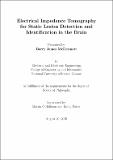| dc.contributor.advisor | O’Halloran, Martin | |
| dc.contributor.author | McDermott, Barry James | |
| dc.date.accessioned | 2020-08-24T10:20:28Z | |
| dc.date.available | 2020-08-24T10:20:28Z | |
| dc.date.issued | 2020-08-20 | |
| dc.identifier.uri | http://hdl.handle.net/10379/16140 | |
| dc.description.abstract | There is a clinical need for a novel approach to the detection of brain haemorrhage and clots. Such static lesions are characteristic of important conditions such as stroke, and traumatic brain injury. In these conditions rapid and definitive detection, and identification of a causative lesion is vital to progressing the patient pathway and ensuring best patient outcomes.
Electrical Impedance Tomography represents an emerging technology that may be capable of translation into a brain haemorrhage and clot detection device. To date Electrical Impedance Tomography has found application in a number of biomedical areas, notably lung monitoring. Electrical Impedance Tomography can detect differences in the electrical conductivity profiles of tissues. As there is notable differences in the electrical conductivity profiles of haemorrhage, clot, and the other tissues of the head this motivates the primary overall research objective: to develop a novel brain haemorrhage and clot static lesion detector using Electrical Impedance Tomography.
Firstly, the clinical need is examined focussing on stroke and traumatic brain injury. The results of this analysis indicate there is a clear need for an efficient, robust, cost-effective, sensitive and specific device for the detection and differentiation of static brain haemorrhage and or ischaemic lesions. Electrical Impedance Tomography is proposed as a solution but key challenges for successful translation are identified such as the acquisition of better real world data, and the development of a dedicated Electrical Impedance Tomography algorithm capable of detecting and identifying static lesions.
Secondly, representative experimental Electrical Impedance Tomography data is generated from numerical models, and then from novel solid phantoms emulating the anatomy and conductivity of tissues of the head. In addition a human Electrical Impedance Tomography stroke data set is leveraged from University College London.
Thirdly, a novel symmetry based algorithm is developed that can detect and identify lesions using Electrical Impedance Tomography data. Machine learning principles are also applied to the output from the algorithm. The proposed algorithm is tested and refined using synthetic data, and experimental data. The proposed algorithm is then applied to the clinical data from University College London, which includes data from patients both with and without brain lesions.
These results suggest that the proposed algorithm can detect and identify stroke lesions in human patients. However, the synthetic data, experimental data, and clinical data all highlight that results are affected by electrode placement errors, and variations in patient anatomy. More work needs to be done to address ways to mitigate against, or improve the robustness of the algorithm to such errors.
In summary, this thesis examines and develops Electrical Impedance Tomography as a technology for detection of brain haemorrhage and clot lesions. A novel algorithm is proposed and tested that could be the basis of translation of Electrical Impedance Tomography into clinical use for such an application. | en_IE |
| dc.publisher | NUI Galway | |
| dc.rights | Attribution-NonCommercial-NoDerivs 3.0 Ireland | |
| dc.rights.uri | https://creativecommons.org/licenses/by-nc-nd/3.0/ie/ | |
| dc.subject | Electrical Impedance Tomography | en_IE |
| dc.subject | Machine Learning | en_IE |
| dc.subject | Medical Imaging | en_IE |
| dc.subject | Reconstruction Algorithm | en_IE |
| dc.subject | Tissue Mimicking Materials | en_IE |
| dc.subject | Stroke Diagnosis | en_IE |
| dc.subject | Electrical and Electronic Engineering | en_IE |
| dc.subject | Engineering and Informatics | en_IE |
| dc.title | Electrical impedance tomography for static lesion detection and identification in the brain | en_IE |
| dc.type | Thesis | en |
| dc.contributor.funder | Hardiman Scholarship, National University of Ireland Galway | |
| dc.local.note | Important medical conditions such as stroke and traumatic brain injury involve clots or bleeds in the brain that must be detected and identified before treatment can begin. This thesis investigates the using the electrical properties of the brain, the symmetry present in the brain, and machine learning in order to achieve diagnosis. | en_IE |
| dc.local.final | Yes | en_IE |
| nui.item.downloads | 324 | |


